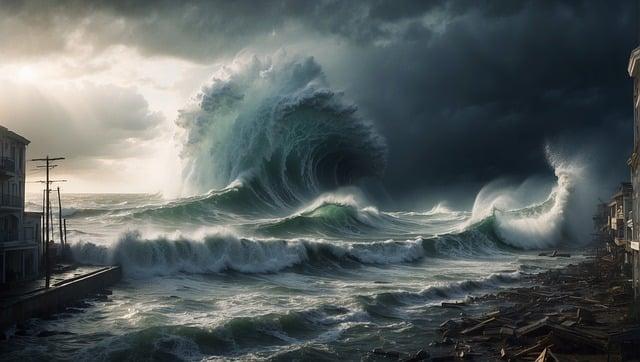- Introduction
- Causes of Tidal Waves
- Effects of Tidal Waves
- Mitigation Strategies
- Notable Tidal Waves in History
- Conclusion
- FAQs
Introduction
Tidal waves, also known as tsunamis, are natural disasters characterized by a series of gigantic waves caused by underwater volcanic eruptions, landslides, or earthquakes. These powerful waves can wreak havoc on coastal areas and have significant implications for human lives and the environment.
Causes of Tidal Waves
Tidal waves are primarily triggered by seismic events such as earthquakes, volcanic eruptions, or underwater landslides. When these events displace a large volume of water, they generate a series of waves that can travel across vast distances in the ocean. The energy from the initial disruption builds up as the waves move towards the shore, resulting in the devastating impact of a tsunami.

(Image: Pixabay/@alfaunicorn81)
Apart from seismic activities, meteorite impacts and explosive volcanic eruptions can also cause tidal waves. Understanding the various causes of tsunamis is crucial for implementing effective early warning systems and disaster preparedness measures.
Effects of Tidal Waves
The effects of tidal waves can be catastrophic, leading to widespread destruction of coastal infrastructure, loss of lives, and environmental damage. The immense force of a tsunami wave can inundate low-lying areas, causing extensive flooding and erosion along the coastline. Furthermore, the powerful currents generated by tidal waves can drag debris and sediments inland, exacerbating the impact on communities.

(Image: Pixabay/@alfaunicorn81)
In addition to the immediate physical damage, tidal waves can also disrupt economies, livelihoods, and ecosystems in the affected regions. Recovery and rebuilding efforts following a tsunami often require significant resources and long-term planning to mitigate future risks.
Mitigation Strategies
To reduce the destructive impact of tidal waves, various mitigation strategies can be implemented. These include early warning systems that detect seismic activity and rapidly communicate alerts to at-risk populations, allowing for timely evacuation. Additionally, coastal engineering projects such as the construction of seawalls and natural barriers can help mitigate the force of incoming tsunami waves and protect vulnerable communities.

(Image: Pixabay/@Clker-Free-Vector-Images)
Community preparedness, emergency drills, and public awareness campaigns play a crucial role in enhancing resilience to tidal waves. By adopting a comprehensive approach that combines structural interventions with risk reduction measures, societies can better safeguard themselves against the potential devastation of tsunamis.
Notable Tidal Waves in History
Throughout history, several notable tidal waves have left a profound impact on civilizations. The 2004 Indian Ocean tsunami, triggered by a massive earthquake, remains one of the deadliest tsunamis in recorded history, claiming hundreds of thousands of lives and affecting multiple countries. Other historic tsunamis, such as the 2011 Japan tsunami and the 1755 Lisbon earthquake tsunami, serve as reminders of the destructive power of these natural phenomena.

(Image: Pixabay/@shades3d)
Studying the history of notable tidal waves provides valuable insights into the behavior of tsunamis and informs modern disaster response and preparedness efforts aimed at minimizing casualties and damage in the event of future events.
Conclusion
Tidal waves are formidable forces of nature that demand respect and proactive measures to mitigate their impact. By understanding the causes, effects, and historical significance of tsunamis, societies can work towards building resilience and reducing vulnerabilities in coastal areas prone to these natural disasters.
FAQs
How are tidal waves different from regular ocean waves?
Tidal waves, or tsunamis, are distinct from regular ocean waves in terms of their origin and sheer power. While ocean waves are typically generated by wind or tides, tsunamis result from seismic events that displace large volumes of water, leading to massive wave formations.
Can tidal waves be predicted in advance?
While it is challenging to predict the precise occurrence of tidal waves, advancements in early warning systems and seismological monitoring have enabled authorities to issue tsunami alerts based on seismic activity. These warnings provide crucial time for coastal communities to evacuate and minimize the impact of incoming tsunami waves.

